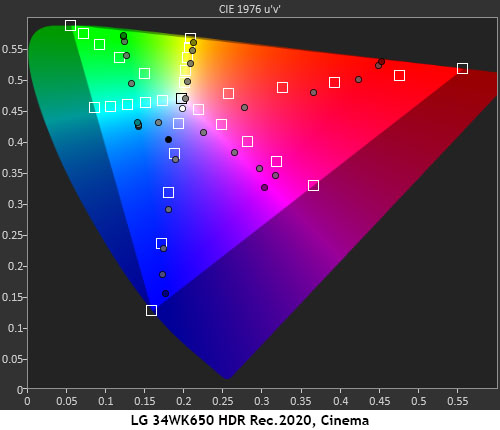LG 34WK650 Monitor Review: Ultra-Wide Gaming Value
Why you can trust Tom's Hardware
HDR Grayscale, EOTF & Color
To run HDR benchmarks, we add an HD Fury Integral to the signal chain to simulate HDR10 content from our Accupel DVG-5000 pattern generator. This enables us to measure the 34WK650’s grayscale in 5% increments, EOTF (electro-optical transfer function) tracking and color gamut capabilities within a Rec.2020 container.
Grayscale Tracking & EOTF



Like every HDR monitor we’ve reviewed so far, the 34WK650 doesn’t offer adjustments for HDR picture modes. There are four presets: Vivid, Standard, Game and Cinema. Vivid was so blue that you’ll instantly want to reach for that OSD button. We consider it unusable. Standard and Game were tolerable, but Cinema looked the best. You can see in the RGB chart that it is still visibly blue, but in actual content, the error wasn’t super obvious. EOTF, HDR’s version of gamma, tracked extremely well with only tiny variations at 20 percent and at the transition point of 60 percent. Despite this monitor’s average contrast level, it was able to make the most out of HDR material, thanks to its luminance accuracy.
Color Gamuts Within Rec.2020



If there were a way to adjust the 34WK650’s HDR grayscale, we would’ve been able to fix the tracking of that red primary. You can see in all the charts that it was skewed toward the magenta zone of the triangle thanks to that too-blue white point. That error also pulled the cyan secondary toward blue and away from green.
Saturation tracking was effective at simulating extended color by over-shooting targets up to the point where the panel runs out of color. We’re still talking about an sRGB screen here, so all LG can do is alter the red and green hues at 100%. Rec.709 isn’t a problem, but the monitor couldn’t quite get there in the DCI-P3 and Rec.2020 charts.
Every HDR monitor we’ve reviewed thus far takes a slightly different approach to color interpretation. LG’s version works reasonably well, and at this price, we can’t complain too loudly. Reference-level accuracy will cost you a whole lot more money. So, how does this all work in practice? Let’s spin a few shiny discs and see.
Ultra HD Blu-rays
When it came to watching movies, the 34WK650 did most things well but missed a couple of items. On the plus side, it handled 24p film cadences (works at 24 frames per second and uses progressive scanning, which draws the lines of each frame in sequence) properly, synced perfectly with our Philips BDP-7501 Ultra HD Blu-ray player, accepted an Ultra HD signal and provided excellent contrast with deep blacks and highlights that popped without being too harsh. But that blue-tinted white point was visible, especially when there were a lot of neutral tones in the image. One example is the office interiors in The Martian. They are cool by design, but this monitor made them even cooler, to the point where some detail was lost. Actors’ faces sometimes lost their texture and looked slightly pasty. But the monitor did a great job with primary colors. The scenes showing Martian landscapes glowed with brilliant reds and oranges. On those scenes alone, you could easily think they’re watching a DCI-capable display.
The other thing we miss is a vertical stretch mode. To be fair, we haven’t seen one in any 21:9 format monitor yet, which is a head-scratcher because this aspect ratio almost perfectly matches the shape of cinemascope: 2.40:1. Still, manufacturers have yet to take advantage of the ability to lose those pesky black bars. When we watched Creed, we tried using the Original aspect mode to remove shape distortion. It worked, but then we had bars on all sides. So ultimately, the 34WK650 is merely even with the competition when it comes to movies.
Get Tom's Hardware's best news and in-depth reviews, straight to your inbox.
MORE: Best Gaming Monitors
MORE: How We Test Monitors
MORE: All Monitor Content
Current page: HDR Grayscale, EOTF & Color
Prev Page Grayscale, Gamma & Color Next Page Viewing Angles, Uniformity, Response & Lag
Christian Eberle is a Contributing Editor for Tom's Hardware US. He's a veteran reviewer of A/V equipment, specializing in monitors. Christian began his obsession with tech when he built his first PC in 1991, a 286 running DOS 3.0 at a blazing 12MHz. In 2006, he undertook training from the Imaging Science Foundation in video calibration and testing and thus started a passion for precise imaging that persists to this day. He is also a professional musician with a degree from the New England Conservatory as a classical bassoonist which he used to good effect as a performer with the West Point Army Band from 1987 to 2013. He enjoys watching movies and listening to high-end audio in his custom-built home theater and can be seen riding trails near his home on a race-ready ICE VTX recumbent trike. Christian enjoys the endless summer in Florida where he lives with his wife and Chihuahua and plays with orchestras around the state.
-
LinuxDevice The Acer CB351C 35" Ultra-Wide isn't too bad, and costs below $300. It could use a bit faster response time, but I find it is has a better image than the previous ASUS monitor it replaced. It doesn't have gsync or freesync.Reply -
milkod2001 Price is low so we can't complain about pathetic resolution. Wonder how long it will take till ve get 32''4k non curved,100Hz factory calibrated decent monitors, good enough for games but also for content creation.Reply
